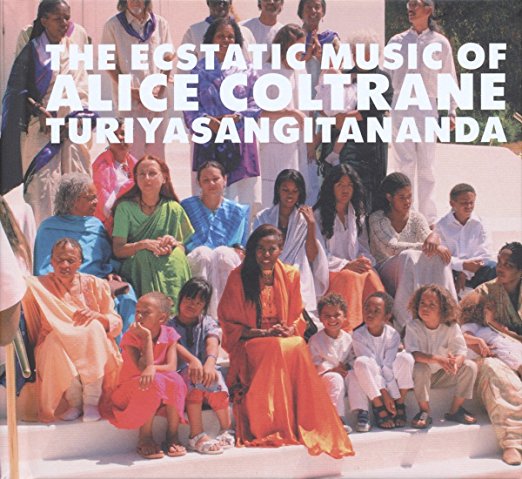
Alice Coltrane
World Spirituality Classics 1: The Ecstatic Music of Alice Coltrane Turiyasangitananda
Release Date: May 5, 2017
Genre(s): Jazz, New Age, Religious, Sacred Traditions
Record label: Luaka Bop
Music Critic Score
How the Music Critic Score works
Buy World Spirituality Classics 1: The Ecstatic Music of Alice Coltrane Turiyasangitananda from Amazon
Album Review: World Spirituality Classics 1: The Ecstatic Music of Alice Coltrane Turiyasangitananda by Alice Coltrane
Excellent, Based on 8 Critics
Based on rating 9/10
The title of this record is evidenced by the very first notes of opening track "Om Rama." A chorus of chanters armed with hand claps and tambourines light into a Hindu Bhajan, accompanied by Alice Coltrane's whirling Wurlitzer organ as she lays down brooding bass notes with one hand, moves her feet across those pedals with authority, and plays glissandi synth with the other hand -- immediate ecstasy. Then John Panduranga Henderson -- who sang with Ray Charles -- delivers a moaning, gospelized solo as Coltrane vamps on his blues. This isn't common Hare Krishna chanting, folks.
Based on rating 8.8/10
Ashrams, physically speaking, are not easy to reach. Traditionally set at some remove, they are expanses of nature and silence and deliberate living that involve meditation, yoga, and communal meals. They instill a pleasant buzz. To visit the Sai Anantam Ashram, which Alice Coltrane founded and directed from 1983 until her death a decade ago, required a winding and mountainous Southern California drive; one could easily miss the gate.
Based on rating 4/5
You're 30 years old. Your husband of only two years has passed away, leaving you with four children to raise. Your career is as tied to your husband's legacy as your surname. Your reputation is somewhat of a "free jazz Yoko", the perceived leading astray of your husband now underlined by your own self-taught excursions from keys to the harp.
Based on rating 4/5
I n the decades following the death of her husband, John, the jazz musician Alice Coltrane deeply immersed herself in eastern philosophy. She changed her name to Turiyasangitananda, became a spiritual leader in the Vedic religion, and founded an ashram on 48 acres of land in southern California, attracting dozens of followers. These tracks are drawn from four rare, cassette-only releases that were distributed to devotees between 1983 and 1995.
Based on rating 3/5
T he spiritually questing output of the late Alice Coltrane, wife of sax genius John, was for many years too way out even for hardened jazzniks. These days, her albums are feted. This compilation draws from her later years when she led a Californian ashram and issued her music on cassettes for the faithful. The mood is prayerful and contemplative, the music a mix of synth drones, Krishna-style chants and Coltrane's poised, yearning vocals.
Opinion: Excellent
The Sai Anantam Ashram surely revolved around Alice Coltrane like a hive around its queen. Even ten years after her death the website for the ashram — now simply the Vedantic Center in Agoura Hills, CA — drops the name “A.C. Turiyasangitananda” on nearly every page. It was her music that was distributed on now-coveted tapes to her followers and wafted from speakers set at the ashram’s entrance in the back roads of Agoura Hills, CA.
Opinion: Excellent
"Alice Coltrane?" The sneer in the scholar's voice was palpable and final. "That stuff is wallpaper." When such bombshell pronouncements are dropped, their force propels me to dig in to what is being dismissed. This excellent release is a multileveled culmination, marking what would have been the artist's eightieth year and the first widely available and vividly restored release of music from a very important phase of her music.
Opinion: Excellent
Alice Coltrane released A Monastic Trio, her first album as a bandleader, in 1968, one year after the death of her husband and collaborator John Coltrane. Over the next decade, working as a composer, pianist, and harpist, Coltrane produced a revelatory body of work at a rate of about an album a year, playing thick and exploratory modal jazz imbued with a sense of spiritual questing that was entirely her own. Then, after the release of the live double album Transfiguration in 1978, she disappeared from public life almost entirely, returning to recording only for her final album Translinear Light, just a few years before her own death in 2007.
'World Spirituality Classics 1: The Ecstatic Music of Alice Coltrane Turiyasangitananda'
is available now

